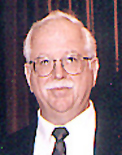DTP Branches and Offices
Research Paradigm (1989-Present)

Dr. Kenneth D. Paull, former chief of DTP’s Information Technology Branch. Courtesy of The NIH Record. 7 April 1998.
COMPARE paper published
To date, DTP has evaluated more than 88,000 pure compounds and more than 34,000 crude extracts against the panel of human tumor cell lines. In the new millennium, DTP continues to use the cell line assay and COMPARE as tools to determine if a test drug’s pattern of cell line responsiveness is similar to that of a drug of known mechanism. More importantly, COMPARE is used as a tool to search for molecular targets relevant to the growth inhibitory activity/cytotoxicity of a compound.4
DTP’s anticancer screening program generates vast quantities of data that are captured in a computerized database. The COMPARE algorithm developed by Dr. Kenneth Paull greatly enhanced the value of the human tumor cell line assay as a discovery tool.
The current in vitro anticancer screen, which is used to evaluate the efficacy of synthetic compounds and natural products, was developed over several years and initiated in April 1990. The current version employs 59 human tumor cell lines that have been grouped in disease subpanels. At maximum capacity, the screen evaluated approximately 1,000 compounds and natural product extracts each month. The decision that there would be no alteration of the assay method and cell lines employed in the screen for an extended period of time permitted the evaluation of thousands of compounds under identical conditions.1
To date, DTP has evaluated more than 88,000 pure compounds and more than 34,000 crude extracts against the panel of human tumor cell lines. The resultant data are analyzed using a program called COMPARE. A probe or "seed" compound can be specified by using the compound's NCI accession number (the NSC number). The COMPARE algorithm then proceeds to rank the entire database of tested compounds in the order of the similarity of the responses, shown as mean cell graph "fingerprints" or patterns, of the cell lines to the compounds in the database to the responses of the cell lines to the seed compound. Similarity of pattern to that of the seed is expressed quantitatively as a Pearson correlation coefficient. The results obtained with the COMPARE algorithm indicate that compounds high in this ranking may possess a mechanism of action similar to that of the seed compound.1
An early example of the use of COMPARE in drug discovery was in the NCI intramural laboratory of Dr. Susan Bates. Her work on epidermal growth factor receptor (EGFR) expression across the cell lines in the screening panel led to the first NCI publication of a measurement of a cancer-relevant molecular target. The resulting EGFR mean graph pattern was compared to the database of tested compounds. Compounds with the highest Pearson correlation coefficients were sent to the Bates lab for testing. One of the compounds confirmed in the laboratory as having a growth inhibitory mechanism related to EGFR is in development for clinical trials.2
In 1985, the hypothesis was put forward that the screen could discover cell-type specific agents with clinical activity against solid tumors. The emerging reality is that correlation of in vitro histology to clinical activity is poor, but the pattern of cellular sensitivity and resistance of the cell lines to the drug correlates with molecular target expression.3
1 Paull KD, Hamel E, Malspeis L. COMPARE Introduction. Prediction of Biochemical Mechanism of Action from the In Vitro Antitumor Screen of the National Cancer Institute.
2 Bates SE. Molecular targets in the National Cancer Institute drug screen. J Cancer Res Clin Oncol 1995;121:495–500.
3 Sausville EA, Johnson JI. Molecules for the millennium: how will they look? New drug discovery year 2000. Br J Cancer 2000;83:1401–1404.
4 Monks A, Scudiero DA, Johnson GS, Paull KD, Sausville EA. The NCI anti-cancer drug screen: a smart screen to identify effectors of novel targets. Anti-Cancer Drug Des 1997;12:533–541.
Link:





